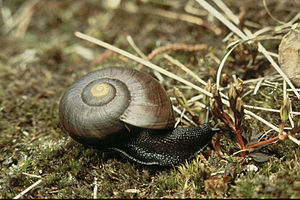Powelliphanta marchanti
| Powelliphanta marchanti | ||||||||||||
|---|---|---|---|---|---|---|---|---|---|---|---|---|

Powelliphanta marchanti , Taihape (?), 1986 |
||||||||||||
| Systematics | ||||||||||||
|
||||||||||||
| Scientific name | ||||||||||||
| Powelliphanta marchanti | ||||||||||||
| ( Powell , 1932) |
Powelliphanta march anti is the name of a predatory living snail from the family Rhytididae in the subordination of terrestrial snails (gastropod), which in New Zealand is widespread.
features
The shell of Powelliphanta marchanti is similar in size and shape to that of Powelliphanta hochstetteri . In contrast to this, it has no colored bands or zones at the base and is pale gray at the parietal allus. The surface of the case is yellowish brown, the protoconch is pale yellowish, the inside of the case mouth is dark gray. Dorsally the shell has pale spiral bands and darker brown lines; ventrally it is monochrome. The house of the adult snail has five and a half slowly increasing coils. The dorsal surface is finely striped towards the periphery, the ventral surface is smooth and shiny. The navel takes up about a seventh the large diameter of the base. The very oblique and broadly elliptical case mouth is strongly cut out. The blunt muzzle, the edges of which are connected by a whitish callus, is covered by the strong periostracum . The diameters of the house are 43 mm and 52 mm and the height around 28 mm. The central teeth of the radula are significantly smaller and slimmer than the innermost lateral teeth. The latter are very similar to those of Powelliphanta hochstetteri .
Distribution and occurrence
Powelliphanta marchanti is endemic to the North Island of New Zealand , where it was found at around 1200 m altitude in Mokai-Patea at the confluence of the Mangatera and Rangitikei on the Ruahine Range .
It occurs in the highlands at altitudes of 1000 to 1470 meters above sea level under the grass Microlaena avenacea and leaf litter in damp forests with Nothofagus fusca and Libocedrus bidwillii in Ruahine Corner , also under shrubs of Olearia colensoi and Dracophyllum longifolium in the southern Ruahine Ranges as well as under grasses in mountain grassland ( tussock ). It is most common on lime-rich subsoil. It is also found under leaf litter in forests with Leptospermum scoparium and Nothofagus solandri in Kaimanawa and Kaweka .
Life cycle
Like other species of the genus Powelliphanta , Powelliphanta marchanti is long-lived and only lays a few eggs per year after the hermaphrodites have fertilized each other .
nutrition
The diet of Powelliphanta marchanti consists, like other representatives of the genus Powelliphanta, mainly of earthworms , which are grasped with the radula and crushed in the foregut with the radula teeth.
Predators and threats
Like other Powelliphanta species, Powelliphanta marchanti is particularly threatened by introduced predatory mammals . The most important role here is played by the imported climbing bag Trichosurus vulpecula , which eats all stages of development of the snail. In addition, the deforestation of the forests, especially for the production of pastureland and the destruction of the habitat through browsing or being represented by imported goats and cattle, leads to a decline in snails. Powelliphanta marchanti is classified by the New Zealand Department of Conservation as a species in "serious decline".
Web links
Individual evidence
- ^ Arthur William Baden Powell , 1932: The Paryphantidae of New Zealand. Descriptions of further new species. Records of the Auckland Institute and Museum 1 (3), pp. 155–162, here p. 158.
- ↑ a b c Kath Walker: Recovery plans for Powelliphanta land snails 2003-2013. Threatened Species Recovery Plan 49, 3. The recovery plans. Pp. 14-18.
- ^ AC O'Connor (1945): Notes on the Eggs of New Zealand Paryphantidae, With Description of a New Subgenus. Transactions of the Royal Society of New Zealand 5 (1945-1946), p 54 -57.